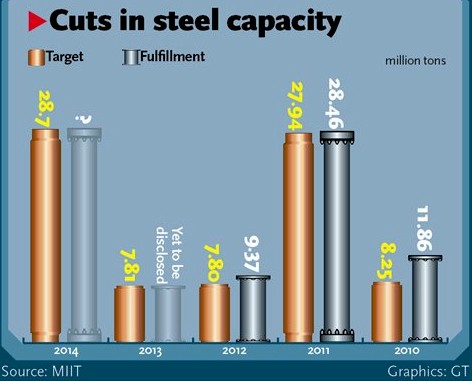

China's economy is facing an unprecedented challenge from industrial overcapacity, and it will take a long time to solve the problem, economists from government think tanks said Thursday.
A new round of overcapacity in China has emerged at a time when many developed countries are seeking to revive their own manufacturing industries, so China can no longer rely on low costs to provide a competitive advantage, Huang Qunhui, director of the Institute of Industrial Economics at the Chinese Academy of Social Sciences (CASS), said at a press briefing on Thursday.
Previously, overcapacity could be absorbed during a period of fast economic growth, but now, as the economy has cooled, China cannot count on growth to absorb excess capacity, Huang said.
Tackling overcapacity is a complicated task that will take a long time to accomplish, Zhang Liqun, an economist at the Development Research Center of China's State Council, said at the same news briefing. It will require a competitive market-based environment, as well as concerted efforts by companies and the government, Zhang noted.
Huang said China aims to transform itself into an industrial powerhouse by 2030 and overcapacity will be a less prominent problem by that time.
China has experienced soaring economic growth over the last decade, fanned by investment, which created overcapacity in a range of energy and resource industries. The problem has become more acute as the economy has slowed down, driving many firms to the brink of bankruptcy.
Overcapacity has also held back improvement in the operation of the industrial sector, with capacity utilization in the steel, electrolytic aluminum, cement, flat glass and shipbuilding sectors remaining below 75 percent, Huang Libin, an official at the Ministry of Industry and Information Technology (MIIT), said in April.
According to a report by the China Iron and Steel Association in April, the steel industry experienced the most difficult time in the first quarter since 2000, with rising inventories, serious oversupply and falling prices. The total inventory of major steel makers hit 15.42 million tons by the end of March, up 32.3 percent from a year earlier.
Another problem for the steel sector is that it has "too many small and poor-quality firms," said Huang from the CASS.
In the latest move to reduce in-efficient capacity in the steel industry, China announced on May 8 a rise in the annual target for cutting steel production capacity.
The target this year is 28.7 million tons, 1.7 million tons more than the target set in a government work report delivered by Premier Li Keqiang in March.
The Ministry of Finance also said on May 7 that the country will subsidize small firms that had shut down their facilities before March 31. This followed an announcement in March by the State Council that it would simplify procedures for approving mergers and acquisitions, to help ease overcapacity.
Meanwhile, according to new standards for assessing local officials released last December, the level of overcapacity, government debt and environmental damage will be key indicators for evaluating local officials' performance, rather than just GDP growth.
"Overcapacity may not necessarily have been caused by slack demand. In the country's central and western regions, there is still strong demand for energy and resources materials," Chen Yao, director of the Institute of Industrial Economics at the Chinese Academy of Social Sciences, told the Global Times Tuesday.
"The misunderstanding here is that tackling overcapacity is just about eliminating excessive production. But the real solution is to adjust the economic structure to get rid of outdated capacity and equipment that causes pollution," Chen said.
Long way to tackling overcapacity
2014-05-23Overcapacity reduction targets raised for 2014
2014-05-09China vows tougher measures on overcapacity
2014-02-19GDP takes back seat to cutting overcapacity
2014-01-28China‘s overcapacity easing: Deutsche Bank
2014-01-15Overcapacity a ‘major challenge for industries‘
2014-01-02Copyright ©1999-2018
Chinanews.com. All rights reserved.
Reproduction in whole or in part without permission is prohibited.